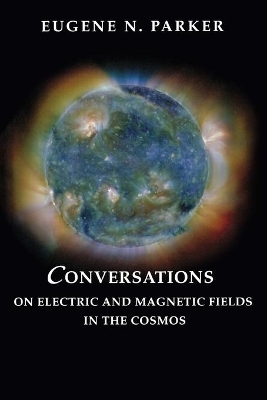
Conversations on Electric and Magnetic Fields in the Cosmos
Princeton University Press (Verlag)
978-0-691-12841-2 (ISBN)
Today's standard textbooks treat the theoretical structure of electric and magnetic fields, but their emphasis is on electromagnetic radiation and static-electric and magnetic fields. In this book, Eugene Parker provides advanced graduate students and researchers with a much-needed complement to existing texts, one that discusses the dynamic electromagnetism of the cosmos--that is, the vast magnetic fields that are carried bodily in the swirling ionized gases of stars and galaxies and throughout intergalactic space. Parker is arguably the world's leading authority on solar wind and the effects of magnetic fields in the heliosphere, and his originality of thought and distinctive approach to physics are very much in evidence here. Seeking to enrich discussions in standard texts and correct misconceptions about the dynamics of these large-scale fields, Parker engages readers in a series of "conversations" that are at times anecdotal and even entertaining without ever sacrificing theoretical rigor.
The dynamics he describes represents the Maxwell stresses of the magnetic field working against the pressure and inertia of the bulk motion of ionized gases, characterized in terms of the magnetic field and gas velocity. Parker shows how this dynamic interaction cannot be fully expressed in terms of the electric current and electric field. Conversations on Electric and Magnetic Fields in the Cosmos goes back to basics to explain why classical hydrodynamics and magnetohydrodynamics are inescapable, even in the deepest reaches of space.
Eugene N. Parker is S. Chandrasekhar Distinguished Service Professor Emeritus of Physics and Astronomy at the University of Chicago.
List of Illustrations xi Acknowledgments xiii Chapter 1: Introduction 1 1.1 General Remarks 1 1.2 Electromagnetic Field Equations 3 1.3 Electrical Neutrality 7 1.4 Electric Charge and Magnetic Field Dominance 12 Chapter 2: Electric Fields 15 2.1 Basic Considerations 15 2.2 Definition of Charge and Field 16 2.3 Concept of Electric Field 17 2.4 Physical Reality of Electric Field 20 2.5 Electric Field Pressure 22 Chapter 3: Magnetic Fields 25 3.1 Basic Considerations 25 3.2 Experimental Connection 26 3.3 Differential Form of Ampere's Law 27 3.4 Energy and Stress 29 3.5 Detecting a Magnetic Field 32 Chapter 4: Field Lines 37 4.1 Basic Considerations 37 4.2 The Optical Analogy 39 Chapter 5: Maxwell's Equations 43 Chapter 6: Maxwell and Poynting 48 6.1 Poynting's Momentum and Energy Theorems 48 6.2 Applications 52 6.3 Electric and Magnetic Fields in Matter 52 6.4 SI Units 55 6.5 Systems of Units 59 6.6 Chaucer Units 63 Chapter 7: Moving Reference Frames 65 7.1 Lorentz Transformations 65 7.2 Electric Fields in the Laboratory 66 7.3 Occam's Razor and the Tree in the Forest 67 7.4 Electric Field in a Moving Plasma 68 7.5 Net Charge in a Swirling Plasma 71 Chapter 8: Hydrodynamics 74 8.1 Basic Considerations 74 8.2 Derivation of the HD Equations 76 8.3 The Pressure Tensor 79 8.4 Pressure Variation in Uniform Dilatations 82 8.5 Shear Flow 85 8.6 Effects of Collisions 86 8.7 Off-diagonal Terms and Viscosity 89 8.8 Summary 91 Chapter 9: Magnetohydrodynamics 92 9.1 Basic Considerations 92 9.2 Diffusion and Dissipation 96 9.3 Application of Magnetic Diffusion 98 9.4 Discussion 101 9.5 Partially Ionized Gases 102 9.6 An Electric Current to Satisfy Ampere 108 9.7 Particle Motion Along B 114 9.8 Time-varying Magnetic Field 119 9.9 Comments 121 Chapter 10: Singular Properties of the Maxwell Stress Tensor 123 10.1 Magnetic Equilibrium 123 10.2 Calculation of the Equilibrium Field 128 10.3 Equilibrium in Stretched Field 129 10.4 Resolving the Contradiction 132 10.5 Formation of TDs 133 10.6 Rapid Reconnection at an Incipient TD 137 10.7 Quasi-steady Dissipation at a TD 142 Chapter 11: Comments 147 11.1 Summary 147 11.2 Electric Circuit Analogy 148 11.3 A Simple Example of an Electric Circuit 149 11.4 Popular Electric and Magnetic Fields 154 Appendix A Electrostatically Driven Expansion of the Universe 157 Appendix B Relaxation of Electric Charge Inhomogeneity 159 Appendix C Imposition of a Large-scale Electric Field 162 Appendix D Electric Charge Density in an Electric Field 165 Appendix E The Transverse Invariant 167 Appendix F Blocking the Flow of Electric Current 169 References 173 Index 179
| Erscheint lt. Verlag | 18.2.2007 |
|---|---|
| Reihe/Serie | Princeton Series in Astrophysics |
| Zusatzinfo | 18 line illus. |
| Verlagsort | New Jersey |
| Sprache | englisch |
| Maße | 152 x 235 mm |
| Gewicht | 312 g |
| Themenwelt | Naturwissenschaften ► Physik / Astronomie ► Astronomie / Astrophysik |
| Naturwissenschaften ► Physik / Astronomie ► Elektrodynamik | |
| ISBN-10 | 0-691-12841-3 / 0691128413 |
| ISBN-13 | 978-0-691-12841-2 / 9780691128412 |
| Zustand | Neuware |
| Haben Sie eine Frage zum Produkt? |
aus dem Bereich


